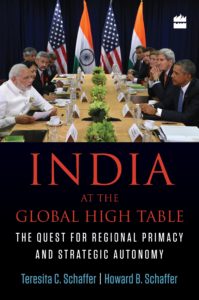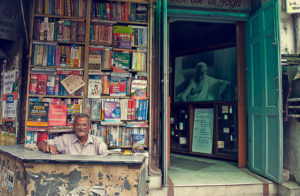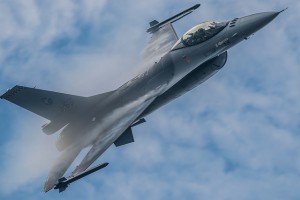Kishan Rana’s review of our India at the Global High Table appeared in the October 2016 issue of The Book Review, New Delhi. The book was published in India by HarperCollins in July 2016, and in Washington by Brookings Institution Press in April 2016. Read the review here. A short review from the September issue of Foreign Affairs appears here.
of The Book Review, New Delhi. The book was published in India by HarperCollins in July 2016, and in Washington by Brookings Institution Press in April 2016. Read the review here. A short review from the September issue of Foreign Affairs appears here.
Book Reviews: South Asia

September 21, 2016: Five interesting additions to the South Asia literature this year. Robert Crews’ Afghan Modern depicts Afghanistan as a nation formed by intense interaction with global powers – an arresting thesis, though he left out some important counterweights. A.S. Dulat, Indian intelligence chief with deep experience in Kashmir, gave us Kashmir: The Vajpayee Years, an irreverent and surprisingly sensible account whose punch line was that talking to everyone is the only way out of today’s impasse. Mark Salter’s To End a Civil War goes deeply into Norway’s effort to resolve Sri Lanka’s two-decade ethnic conflict. Somini Sengupta, a New York Times reporter who spent years in India, provides an extraordinary picture of the “New India.” And Alex Vatanka’s Iran and Pakistan is, surprisingly, the first serious book I have seen on that important relationship.
Read my reviews of all five books here.
This is a preprint of an article submitted for consideration in Survival: Global Politics and Strategy ©, The International Institute for Strategic Studies.
India at the Global High Table: Remarks at Richmond

May 10, 2016: Introducing India at the Global High Table at the Richmond World Affairs Council, we discussed emerging India’s international role, focusing on the main themes of its foreign policy, the competing visions of India’s role in the world, and some examples of India’s negotiating Style. Books are available at Brookings (http://www.brookings.edu/research/books/2016/india-at-the-global-high-table), at Amazon, and in book stores. The text of our remarks follows:
Good evening. It’s a great pleasure for my wife and me to come here to Richmond to talk with you about India and the book we’ve written about the drivers of its foreign policy and diplomatic practices. The two of us have spent a good deal of time as State Department officials working in India and dealing in Washington with Indian Continue reading “India at the Global High Table: Remarks at Richmond”
Harold H. Saunders: Remembering a Peacemaker

March 10, 2016: When Hal Saunders died last weekend, the world lost one of the most creative peace negotiators it has ever known. He is best remembered as the man who gave Jimmy Carter’s vision of an Israel-Egypt peace practical form at Camp David. Having worked for him both during and after his distinguished government career, we think it’s important to highlight two other characteristics that have been lost in most of the early remembrances. First, Hal was an extraordinary boss and colleague. Second, his government career – a couple of decades at the top of the official pyramid – was only the beginning of his contribution to both understanding and doing peacemaking.
Continue reading “Harold H. Saunders: Remembering a Peacemaker”
U.S. Sale of F-16 Jets to Pakistan Riles India

February 20, 2016: U.S. provision of sophisticated Lockheed-Martin F-16 fighter jets to the Pakistan Air Force has been a particular sore point for the Indian government for decades, since the Reagan administration made them available to Islamabad following the Soviet invasion of Afghanistan. The Indians have always contended that whatever the Pakistanis may offer as their rationale for acquiring the planes — whether it is to ward off a possible Soviet attack, their claim in the 1980s, or to use as precision firing platforms to combat terrorists, their present argument – Islamabad’s real purpose is to bolster its air power in a potential confrontation with India. For their part, the Pakistanis have long viewed the F-16 as a potent symbol of where they stand with the United States. Like the Indians, they afford it an outsized military and political significance. Continue reading “U.S. Sale of F-16 Jets to Pakistan Riles India”

